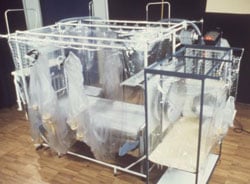Overnight New York City's Health Department confirmed their first Monkeypox case - raising the nation's total to only 2 - but that number is expected to rise. A second suspected case has been ruled out by laboratory testing.
The brief announcement follows, after which we'll look at the CDC's infection control recommendations for Monkeypox.
May 20, 2022 — The NYC Department of Health and Mental Hygiene’s Public Health Lab has tested specimens from two patients under investigation for possible monkeypox. One case has been ruled out and another has been identified as positive for Orthopoxvirus, the family of viruses to which monkeypox belongs. Confirmation for monkeypox is pending CDC testing.The patient is isolating, and – treating this case as a presumptive positive until confirmed – the Health Department is carrying out contact tracing.Masks can protect against monkeypox, as well as other viruses circulating in New York City, such as COVID-19. The Department continues to recommend masks in public indoor settings. As a precaution, any New Yorkers who experience flu-like illness with swelling of the lymph nodes and rashes on the face and body should contact their health care provider.Monkeypox is rare but can spread through close contact with an infected person or animal. This includes via respiratory droplets – usually after prolonged contact -- body fluids or other forms of close contact, such as sharing clothes or other materials that have been used by someone who is infectious.
###
While the risk of contracting the virus via casual contact is probably quite low, over the past decade we've seen increasing evidence that Monkeypox is becoming more transmissible. In 2013, the DRC reported a 600% increase in cases over both 2011, and 2012 (see EID Journal:Extended H-2-H Transmission during a Monkeypox Outbreak).
Granted, this study was on the more severe Congo Basin clade.
The authors also cited a higher attack rate, longer chains of infection, and more pronounced community spread than have earlier reports, and many scientists believe the global decline in smallpox immunity over the past 40 years has raised the risks of Monkeypox transmission.
While some public health agencies seek to downplay the transmissibility of Monkeypox (see UN.org Minimal risk of monkeypox transmission in UK), in truth, we don't have a lot of good data on the subject.
There are few scientific studies pertaining to the transmission of monkeypox virus and most were conducted in Africa. Person-to-person transmission of monkeypox virus is believed to occur by the same mechanisms exploited by variola virus during the smallpox era, namely via respiratory droplets or by direct contact with lesion material.
Isolate patients suspected of having monkeypox in a negative air pressure room as soon as possible.
They also recommend:Equipment (PPE)
Personal protective equipment should be donned before entering the patient’s room and used for all patient contact. All PPE should be disposed of prior to leaving the isolation room where the patient is admitted.
Optimal personal protective measures include:
- Use of disposable gown and gloves for patient contact.
- Use of NIOSH-certified N95 (or comparable) filtering disposable respirator that has been fit-tested for the healthcare worker using it, especially for extended contact in the inpatient setting.Visit The National Personal Protective Technology Laboratory (NPPTL) for frequently asked questions and answers about wearing respirators versus surgical masks.
- Use of eye protection (e.g., face shields or goggles), as recommended under standard precautions, if medical procedures may lead to splashing or spraying of a patient’s body fluids.
Additional Precautions
In addition to isolating infectious patients and use of PPE when caring for patients, other standard precautions can limit the transmission of monkeypox virus.
These include:
- Proper hand hygiene after all contact with an infected patient and/or their environment during care.
- Correct containment and disposal of contaminated waste (e.g., dressings) in accordance with facility-specific guidelines for infectious waste or local regulations pertaining to household waste.
- Care when handling soiled laundry (e.g., bedding, towels, personal clothing) to avoid contact with lesion material.Soiled laundry should never be shaken or handled in manner that may disperse infectious particles.
- Care when handling used patient-care equipment in a manner that prevents contamination of skin and clothing.Ensure that used equipment has been cleaned and reprocessed appropriately.
- Ensure procedures are in place for cleaning and disinfecting environmental surfaces in the patient care environment.Any EPA-registered hospital disinfectant currently used by healthcare facilities for environmental sanitation may be used. Follow the manufacturer’s recommendations for concentration, contact time, and care in handling.

